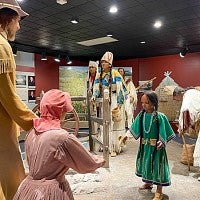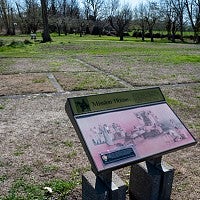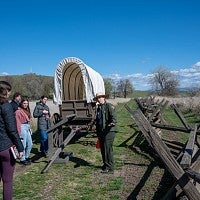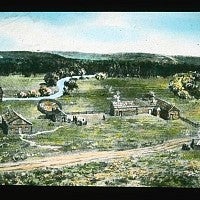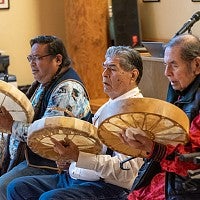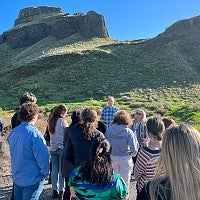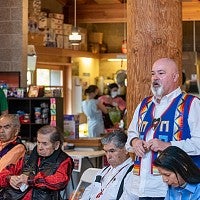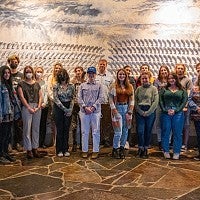For members and friends of the Confederated Tribes of the Umatilla Indian Reservation, June 3 is not an ordinary spring day in Oregon, but an important historical date. Since 1850, it’s been a yearly occasion for somber reflection, ceremony, and remembrance.
And 172 years later, the day marked a renewed sense of hope.
On June 3, 2022, a delegation including elders of the tribes gathered at the Many Nations Longhouse on the University of Oregon campus. They were joined by 18 students who’d come not only to pay their respects, but to share a trove of valuable information they’d collected throughout an intense, 10-week colloquium in the Robert D. Clark Honors College.
“In more than 20 years of teaching, I’ve never been more impressed by a group of students’ collective commitment to a project, or prouder of a class’s accomplishments,” said Michael Moffitt, a professor with the UO School of Law and the honors college.
A specialist in conflict resolution, Moffitt said he developed the 400-level course, titled “Searching for the Cayuse Five,” with funding support from a Philip H. Knight Chair and guidance from Howard Arnett, professor of practice with the School of Law and a leading expert in Indian Law, particularly as it pertains to Oregon’s tribal nations.
The class proved to be so successful that Moffitt, with the Confederated Tribes’ encouragement, is teaching it once again this winter term. Students from 13 different undergraduate majors have signed up. Half of them are veterans of the first course; two others are enrolled members of the Confederated Tribes of the Umatilla.
“The students include sophomores, juniors and seniors, and all of them were selected after a careful and competitive application process,” Moffitt said.
A dark day
The curriculum is addressed to one of the most infamous episodes from Oregon’s early history. On November 29, 1847, Presbyterian missionaries Marcus and Narcissa Whitman and 11 others near Walla Walla were killed in an incident that whites soon came to call “the Whitman Massacre.” However, then as now, the Cayuse had a very different perspective.
“It’s important to emphasize the loaded nature and use of the term ‘massacre,’” said Jennifer Karson Engum, the Confederated Tribes’ cultural anthropologist. “The killings are more appropriately seen as an ‘incident’ in a larger and more complex historical picture.”
In addition to his ministry, Whitman was a medical doctor. In the months prior to the event, he had treated many people in the area, both natives and settlers. But it could not fail to escape notice that most of his patients who died were Cayuse. And under Cayuse law, a medicine man who fails to heal was subject to punishment, sometimes death.
By any regard, the events at the mission marked a major turning point in the state’s formation: the moment when protecting overland settlers took political precedence over negotiating with Indigenous people to resolve issues. With its formal recognition as a U.S. territory in 1848, Oregon’s new leaders were eager to send a law-and-order message.
For nearly three years, an armed posse engaged in conflict with Native Americans throughout much of the Northwest. The Whitman’s attackers, it was believed, had been Cayuse, and the territorial government insisted that the tribe turn over those individuals who were responsible.

The Cayuse 5
In 1850, five Cayuse men — whose names in their language were Ti’ílaka’aykt, Tamáhas, ‘Iceyéeye Cilúukiis, K’oy’am’á Šuumkíin and Łókomus — voluntarily submitted to federal troops and agreed to give depositions about the incident. Their intention was not to confess, but to offer testimony in a spirit of truce, in hopes of ending the Cayuse War.
Instead, the volunteers were arrested, shackled and transported to the territorial capital of Oregon City, south of Portland, where they were tried for Marcus Whitman’s murder. For some of the accused, there was no evidence to link them to the fatal events at the mission. Nonetheless, all five were found guilty. On June 3, 1850, the so-called “Cayuse Five” were executed by hanging, their bodies subsequently moved by handcart to an undisclosed location for burial.
“The history of how they died is known,” Moffitt said. “They were buried somewhere, and all evidence suggests that the burial took place that same day. What we do not know is where. The fact that we do not collectively know their burial site stands in the way of repatriation, of justice, of reconciliation or whatever else those who are living may decide represents the best course of action.”
Honors college students begin to dig
This is where the honors college class came in, building on years of efforts from the tribe and others. Combining their knowledge from a variety of academic majors and backgrounds, the students got to act as “history detectives” for a term.
In collaboration with experts from the Tamástslikt Cultural Institute, the Confederated Tribes’ cultural museum and archival repository, the goal of the class was nothing less than to help the living descendants of the Cayuse Five find the graves of their ancestors.
The class began with a road trip. Travelling by bus from the UO campus in Eugene, 16 students visited McLoughlin Promenade in Oregon City to a spot overlooking the site of the executions. Oregon City officials met them and addressed the importance of the 1850 events in local history.
They were also joined by Engum, who provided insights into the cultural landscape and shared related news clippings, papers, oral histories and other data collected by the tribes over the decades. The documents included five boxes donated by the family of the late Ronald Lansing, author of “Juggernaut,” an exhaustively researched 1993 historical novel about the trial.
For the next two months, the students poured over the materials, along with trial documents, church records, maps, genealogies and other evidence.
Tribal historians add key knowledge
The next stops were Tamástslikt, on the Umatilla Reservation near Pendleton, and the Whitman Mission National Historical Site at Weyíilet, near present-day Walla Walla, Washington. Here the class was led by Roberta Conner, the institute’s director, former Whitman Mission Superintendent Timothy Nitz, and lead interpretive ranger Kate Kunkel-Patterson. They also heard testimony from tribal elders including Les and Armand Minthorn, who are direct descendants of the condemned men.
“They have been stalwart in their efforts to find and honor their ancestors,” Conner said. “The five executed men were closely related. Three were brothers and two were cousins. They are not forgotten, and this work must continue for as long as is necessary.”
From the beginning, it seemed obvious that the class’ search would involve fields of knowledge like history and law, but in the end everything from geography and French, to spatial data science and religious studies would play an important role in following the trail.
“Virtually nothing worth our time can be solved by just looking at one academic discipline,” Moffitt said. “Each student had a day when they were the rock star, and there were all the other days they needed to listen to their colleagues.”
Between formal class sessions and their independent investigative work, he estimates that the students together invested at least 4,000 hours in the project. They’d set out with the hope of providing a definitive answer to the mystery of where the men had been buried. Their work represented progress, but no concrete answer — yet.
The class concluded by providing evidence to support a few potential sites. They also turned up additional clues that could help guide the tribes in the next phase of the search.
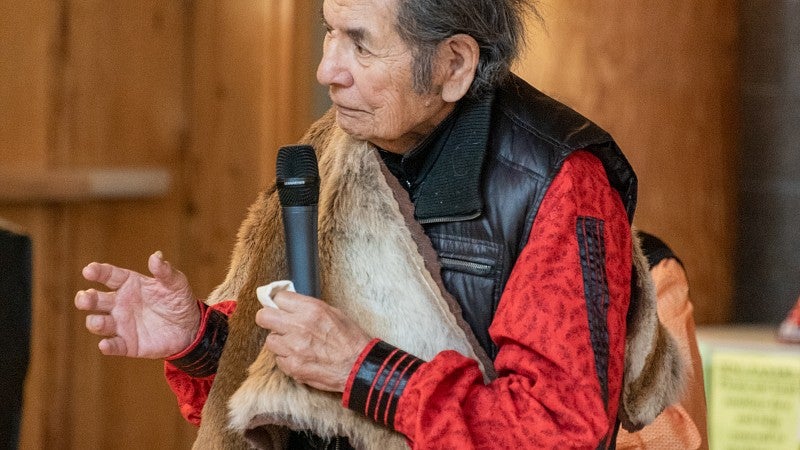
Questions, and work, remain
While the lack of a “definitive answer” was not their desired outcome, according to Moffitt, a wealth of learning nonetheless occurred throughout the process.
“The students have done a daunting amount of work, but a daunting amount of work remains to be done,” he said. “We looked under many stones, and we surely missed some along the way. We did our very best to preserve the records, to assist those who come after us.”
“We have a mind-blowing amount to follow up on with this material,” Conner agreed.
Flash forward to January 2023, and the second section of the course has begun taking the next steps.
“Our tribal partners are eager for us to follow up on some of the most promising of the leads and potential sites we explored in spring 2022,” Moffitt said. “Some of our work will involve a closer examination of research paths we traveled last year. Some of our work will involve new areas of inquiry. I am thrilled and humbled to continue working with the students, the Tribes, and our other partners on this search.”
—By Jason Stone, University Communications / Photos by Wayne Espinola except as noted



